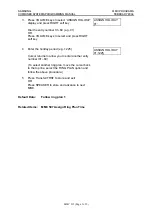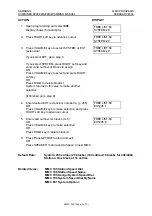
SAMSUNG
MMC PROGRAMS
COMBINED SYSTEMS PROGRAMMING MANUAL
FEBRUARY 2004
MMC 601 (Page 1 of 3)
MMC: 601
ASSIGN STATION GROUP
FOR:
ALL
SYSTEMS
Purpose:
Assigns stations to groups. This provides more flexibility, for example, if using
Uniform Call Distribution (UCD), AA GROUP and VM/AA applications. A station, com-
mon bell, and ring page can be in more than one group, but must all be the same ring
type. The maximum members per group for each system is as shown in the table.
DCS
CI
CII
816 408/408i
i
DCS100
i
DCS500
OS500
Max members
per group
48 30 30 16
8
32
48
48
Note: A device for announcement, if used, must provide a hookflash and return the call to the
group.
The options to program depend on your system, but will be some or all of the following:
G
ROUP
T
YPE
,
R
ING
M
ODE
,
O
VERFLOW
,
G
ROUP
T
RANSFER
,
N
EXT
P
ORT
,
M
EMBER
,
N
EXT
H
UNT
,
G
ROUP
B
USY
and
GROUP AUTO ANSWER
.
GROUP TYPE
Other possible entries are:
3801–3820
COM. BELL
This device is a common bell relay on a Trunk A card.
3601–3640
RING PAGE
This device is ring over an external page zone output of
a Trunk A card.
NORMAL GROUP Station ring group
VMAA GROUP
Group VMAA ports designated in
—can only have distrib-
ute or sequential ringing (see
UCD GROUP
UCD group—has wrap-up capability. See
AA GROUP
AA group—can only have distribute or sequential ringing (see below)
CADENCE or
BI-VMS
Voice Mail group (VM card must be installed in system). Can only
have distribute or sequential ringing (see
MSG
Used to group a number of extensions to serve as a message desk
or message group. When one of the stations in the group leaves a
message for another station, the messaged station will reply to the
message group so any member can answer the call (
i
DCS500 and
OS500 systems only)
S0 Allows
S
0
ports to be members of a station group. Valid members
are MSN numbers assigned to the S
0
bus.
















































